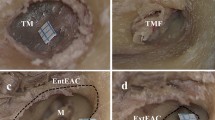Abstract.
Hearing preservation surgery has become an option for an increasing number of patients with vestibular schwannomas due to diagnosis at an earlier stage. The middle cranial fossa approach represents one such surgical approach for resection of vestibular schwannomas with hearing preservation. We have undertaken an anatomical study of the middle cranial fossa approach to the internal auditory meatus using 20 fresh temporal bones. By simulating the surgical approach it was possible to analyze critically two of the main recognized subapproaches to the internal acoustic meatus. The results confirmed that the angle subtended by the facial nerve and "blue-lined" semicircular canal was much less than 60° but equally important was the degree of individual variability. Furthermore the roof of the geniculate fossa was not infrequently dehiscent. The distance measured from the inner table of the craniotomy to the superior semicircular canal was on average 22 mm, similar to previous reports and utilized by some in their approach in this challenging surgery. From this anatomical study it appears that safe dissection of this area is facilitated by observing the more acute angle between the facial nerve and superior semicircular canal and by taking advantage of the relationship between the inner table and important landmarks. The French version of this article is available in the form of electronic supplementary material and can be obtained by using the Springer Link server located at http://dx.doi.org/10.1007/s00276-002-0076-8.
Résumé.
Une chirurgie avec conservation de l'audition est devenue une option possible pour un nombre croissant de patients porteurs d'un schwannome vestibulaire du fait d'un diagnostic plus précoce, à un stade moins évolué. La voie de la fosse cérébrale moyenne représente une possibilité d'abord chirurgical en vue d'une telle exérèse du schwannome vestibulaire avec conservation de l'audition. Nous avons entrepris une étude anatomique de la voie de la fosse cérébrale moyenne vers le méat acoustique interne sur 20 rochers frais. En simulant l'abord chirurgical, il a été possible de faire une analyse critique de deux des principales variantes admises de cet abord du méat acoustique interne. Les résultats confirment que l'angle limité par le nerf facial et la ligne bleue du canal semi-circulaire supérieur fait beaucoup moins de 60 degrés mais que la variabilité individuelle est aussi très importante. Par ailleurs, le toit de la fosse du ganglion géniculé était déhiscent de façon non exceptionnelle. La distance mesurée depuis la table interne de la craniotomie jusqu'au canal semi-circulaire supérieur était en moyenne de 22 mm, comparable à celles rapportées auparavant et utilisées par certains lors de leur approche dans cette chirurgie assez difficile. De cette étude anatomique, il ressort que la dissection sûre de cette région est assurée par la prise en compte de l'angle plus aigu entre le nerf facial et le canal semi-circulaire supérieur et en profitant des rapports entre la table interne et des repères importants.
Similar content being viewed by others
Author information
Authors and Affiliations
Corresponding author
Additional information
Electronic Publication
Electronic supplementary material
Rights and permissions
About this article
Cite this article
Chopra, R., Fergie, N., Mehta, D. et al. The middle cranial fossa approach: an anatomical study. Surg Radiol Anat 24, 348–351 (2002). https://doi.org/10.1007/s00276-002-0076-8
Received:
Accepted:
Published:
Issue Date:
DOI: https://doi.org/10.1007/s00276-002-0076-8




